Key takeaways:
- Portable reflectors are crucial for enhancing lighting in photography, allowing for creative manipulation of light and mood.
- Different types of reflectors (silver, gold, white) serve distinct purposes, affecting the quality and emotional impact of images.
- Choosing the right reflector involves considering lighting conditions, size, and material for optimal results.
- Effective use of reflectors requires careful positioning and collaboration, which can lead to dramatic improvements in photographs.
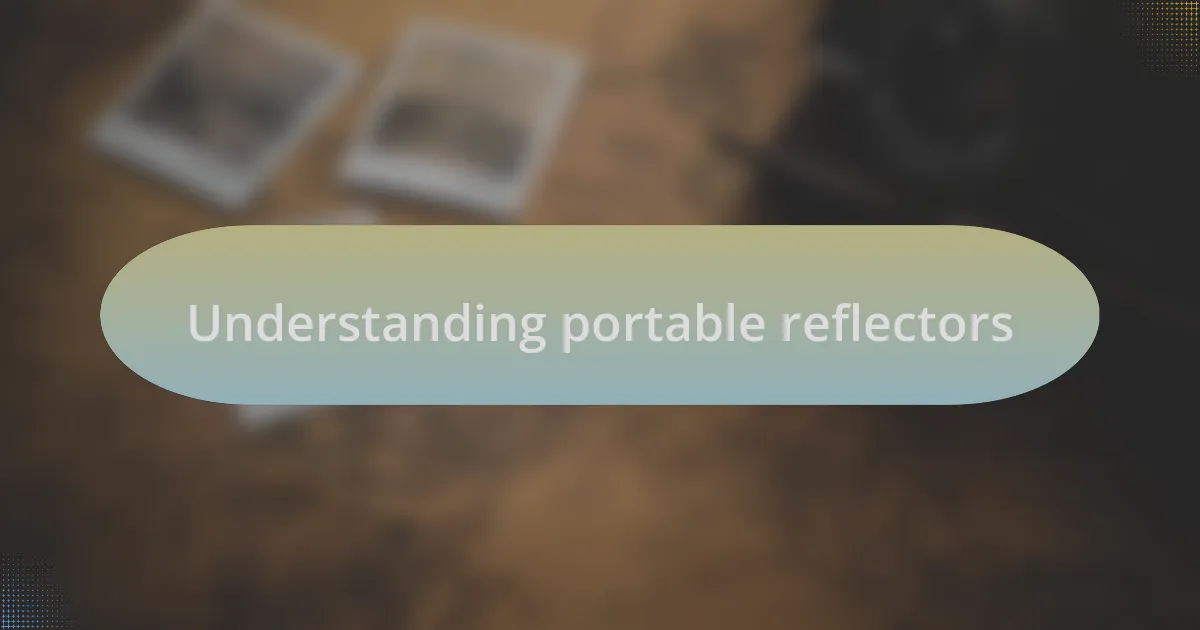
Understanding portable reflectors
Portable reflectors are essential tools for any photographer looking to enhance their lighting on the go. I remember my first photoshoot with a simple reflector; it transformed dull natural light into something magical. Can you imagine the difference a bit of bounce can make to your subjects?
These reflectors come in various shapes and sizes, providing versatility in different shooting environments. For instance, I often use a 5-in-1 reflector kit, which includes a diffuser and various colors to manipulate light creatively. It always surprises me how a change in color from gold to silver can evoke such different moods in my photos.
Understanding how to use portable reflectors isn’t just about reflecting light; it’s about crafting the mood and atmosphere of your shot. I’ve found that the positioning of the reflector can dramatically change the story conveyed in an image, prompting me to ask whether I’m focusing on the warmth of a subject or the dramatic contrast that shadows create. What’s your experience with reflecting light in your photography?
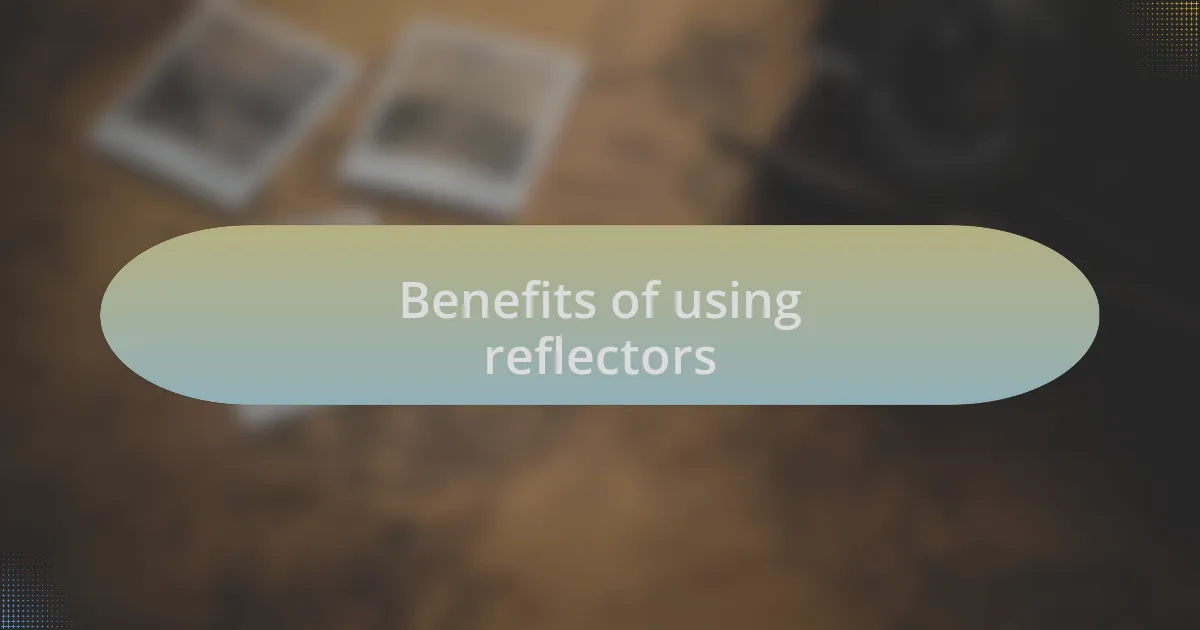
Benefits of using reflectors
Using reflectors can dramatically improve the quality of your photos by enhancing natural light. I recall a shoot in a shaded area where the light was flat and uninviting. Just positioning a reflector at the right angle brought a whole new layer of warmth and dimension to both the subject and the background, making everything pop beautifully.
Another benefit is their portability, which allows for flexibility in shooting locations. I remember one session at the beach, where I needed to combat harsh sunlight. With a compact reflector tucked in my bag, I quickly adjusted the lighting dynamics, transforming an ordinary snapshot into a stunning piece of art simply by bouncing light onto my subject. Isn’t it fascinating how such a lightweight tool can elevate a moment?
Additionally, reflectors can help control shadows, creating a more polished look. For example, I often found that in outdoor shoots, unwanted shadows can distract from the focal point. By using a reflector strategically, I’ve managed to soften or eliminate those harsh shadows, drawing the viewer’s attention exactly where I want it—on the subject. Have you noticed how the tiny tweaks can lead to significant improvements in your work?
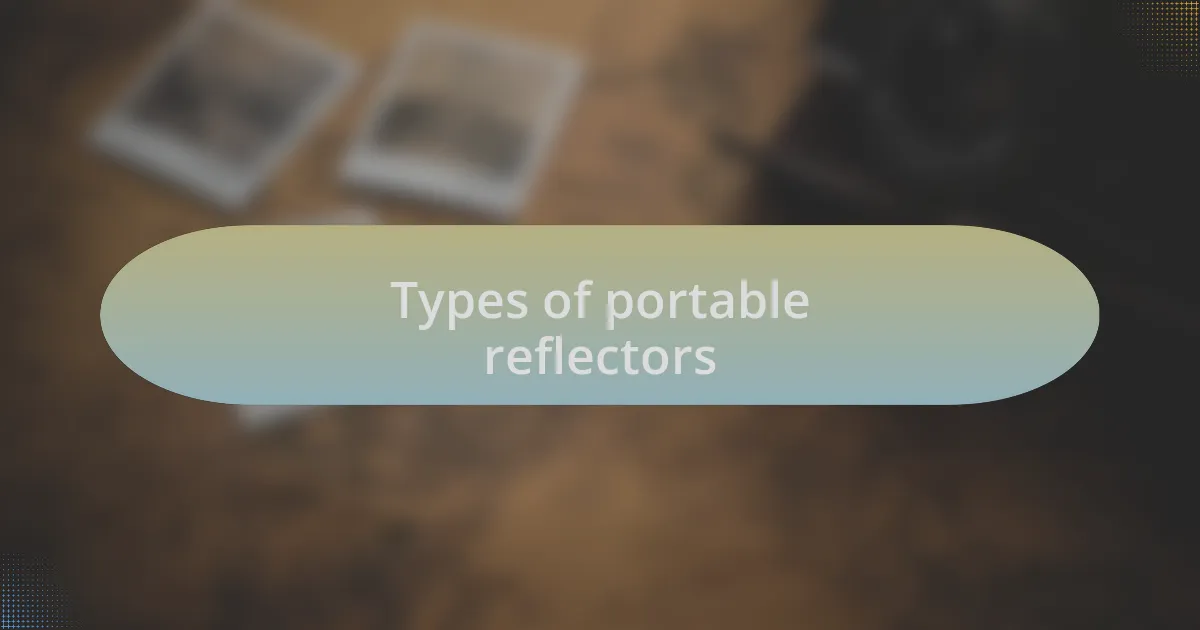
Types of portable reflectors
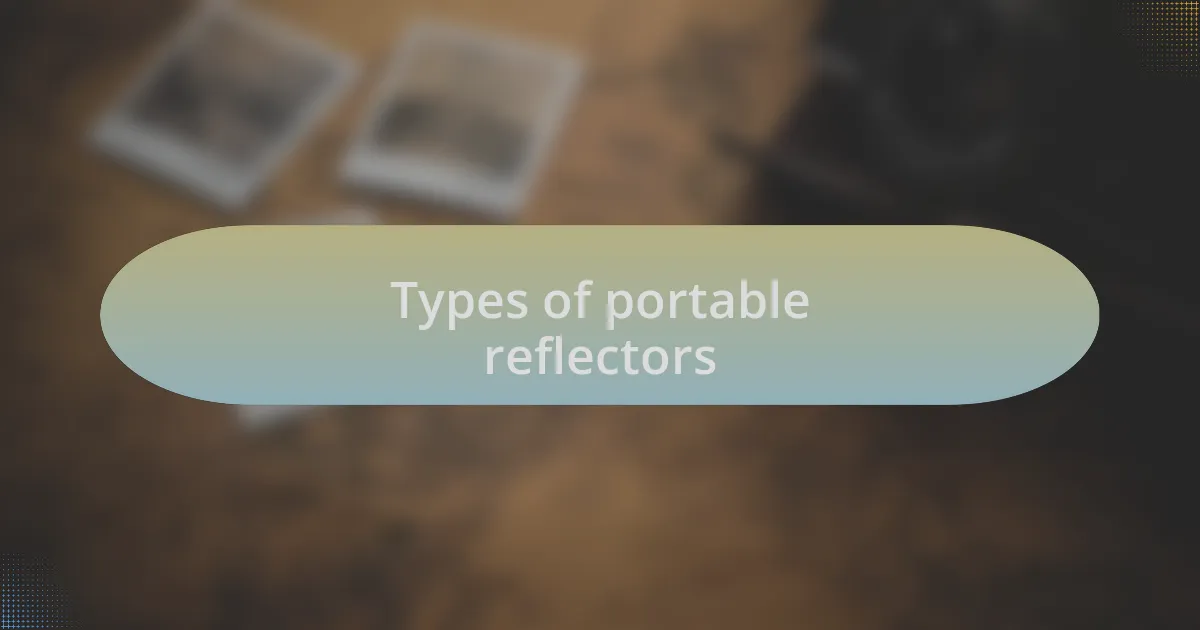
Types of portable reflectors
When it comes to portable reflectors, you typically encounter three main types: silver, gold, and white reflectors. Each serves a distinct purpose. I’ve often grabbed my silver reflector for its ability to boost light intensity, especially in dim settings. It’s incredible how it can create a vibrant catchlight in a subject’s eyes, giving them life.
Gold reflectors, on the other hand, impart a warm glow that’s perfect for enhancing skin tones, particularly during sunset shoots. I remember a picturesque moment where my subject’s complexion transformed under a golden reflector, making them look like they were bathed in warm sunlight, even in the cool evening air. It’s fascinating how such simple color variations can evoke entirely different emotions in a photo.
White reflectors provide a soft and diffused bounce, which is ideal for maintaining a natural look while lightening shadows. I usually opt for this type when I want to keep things subtle and serene. Have you ever experimented with different types in one shoot? I’ve seen firsthand how switching between reflectors can dramatically change the mood and impact of an image, highlighting the versatility of these tools.
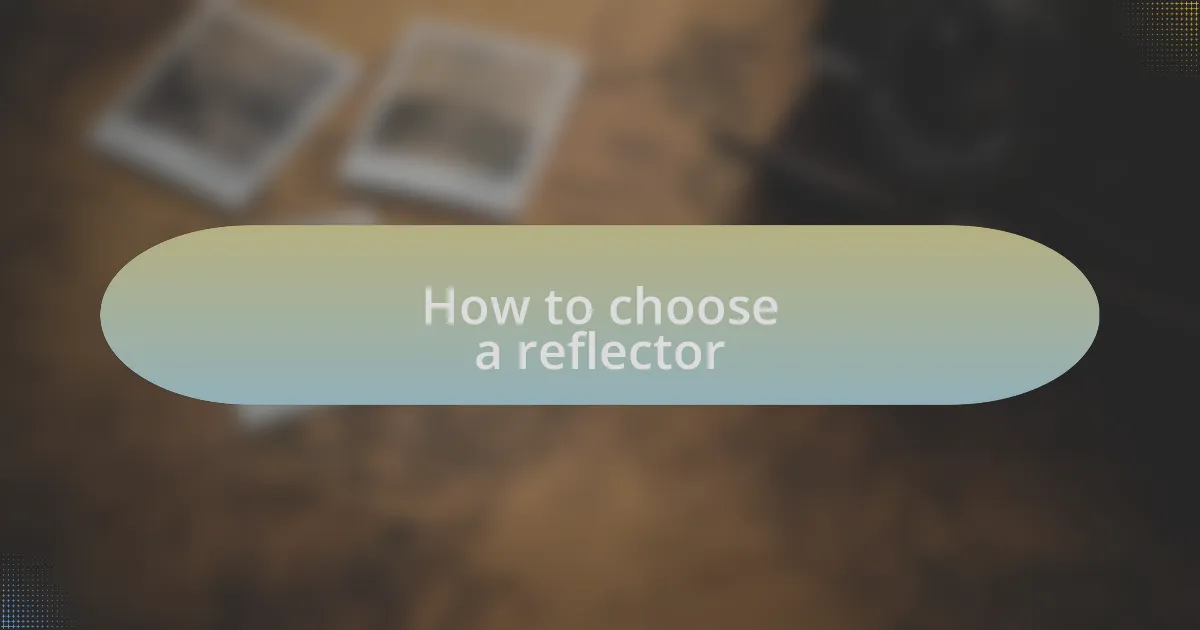
How to choose a reflector
When choosing a reflector, consider the lighting conditions and the effect you want to achieve. I recall a photo session where the light was quite harsh, and I opted for a white reflector to soften those shadows. The result was stunning, turning what could have been an unflattering shot into something elegant and inviting. Have you ever navigated such contrasts in natural light?
Another critical factor is size. Smaller reflectors are portable and perfect for on-the-go shoots, but I’ve found that larger ones can really enhance scene lighting when space allows. I once used a larger gold reflector during a family portrait session in a park, and it created a warm, radiant atmosphere that captured everyone’s smiles beautifully. Isn’t it amazing how the right size can transform the dynamics of a shoot?
Lastly, don’t overlook the foldability and durability of your reflector. Being out in unpredictable weather, I learned the hard way that a flimsy reflector can disrupt a shoot. I now always choose reflectors that are not only easy to pack but can withstand a bit of wind. Trust me, investing in a reliable reflector makes all the difference in achieving the look you envision.
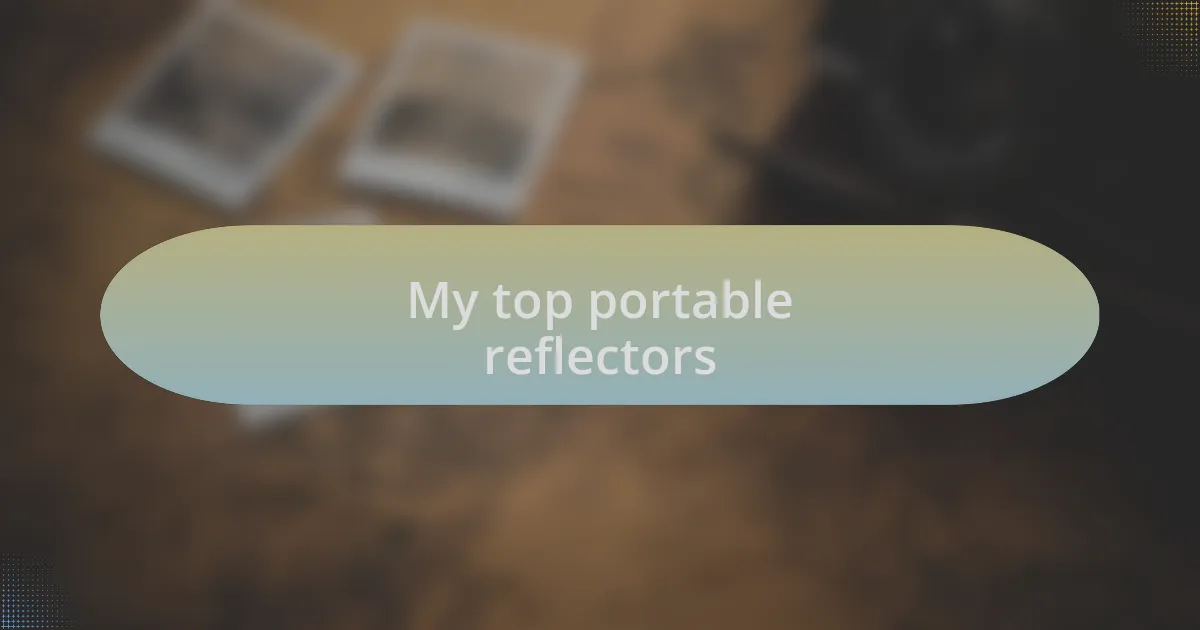
My top portable reflectors
When it comes to portable reflectors, I can’t recommend the 5-in-1 collapsible reflector enough. It’s like having an entire lighting kit in your backpack. I remember a time at a beach shoot; the sun was blaring down, and I effortlessly switched between the gold and silver sides to create stunning highlights and flattering skin tones. Have you ever had one tool completely change the mood of your photos?
Another personal favorite of mine is the circular reflector. Its compact size makes it easy to carry, yet it packs a punch when it comes to directing light precisely where you need it. I once used one during a wedding ceremony—just a quick adjustment to bounce some soft light onto the bride’s face, and it completely transformed her expression in the shots. Don’t you love how a small change can yield such beautiful results?
Lastly, I’ve found that the fabric of the reflector matters more than I initially thought. I had a cotton reflector once that absorbed more light than it reflected, leaving my photos a bit flat. Switching to a high-quality nylon fabric was a game-changer. The difference in clarity and brightness was staggering. Have you considered the material when choosing your reflector? It can truly make or break the overall effect.
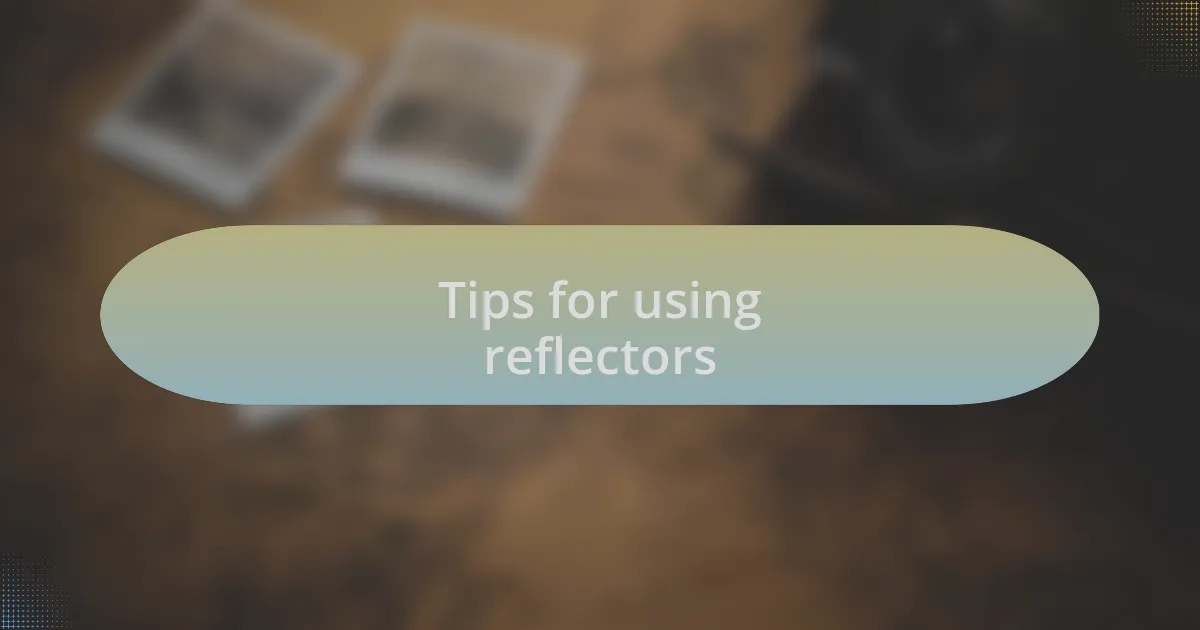
Tips for using reflectors
When using reflectors in photography, positioning is everything. I remember a shoot in a park where I struggled to find the right angle to bounce light onto my subject’s face without casting harsh shadows. After a few adjustments, I discovered that placing the reflector slightly above their line of sight created a softer, more flattering light. Have you thought about how just a minor change in angle can completely enhance the mood of your images?
Always keep in mind the color of the reflector you’re using. During one outdoor portrait session, I mistakenly grabbed a white reflector instead of silver to counteract the midday sun. While it worked, it didn’t have the same dramatic effect that the silver would have provided. The lesson here is clear: matching the reflector to the lighting conditions can really amplify the visual impact. Do you pay attention to these subtle details when you shoot?
Finally, don’t forget about teamwork when using reflectors. On a recent collaborative shoot, we had a friend hold the reflector while I focused on the camera settings. Their enthusiasm kept the energy up, and we captured such spontaneous moments that way. Have you considered involving others in your shoots to make the process more enjoyable? It’s a simple but effective way to enhance both the experience and results.
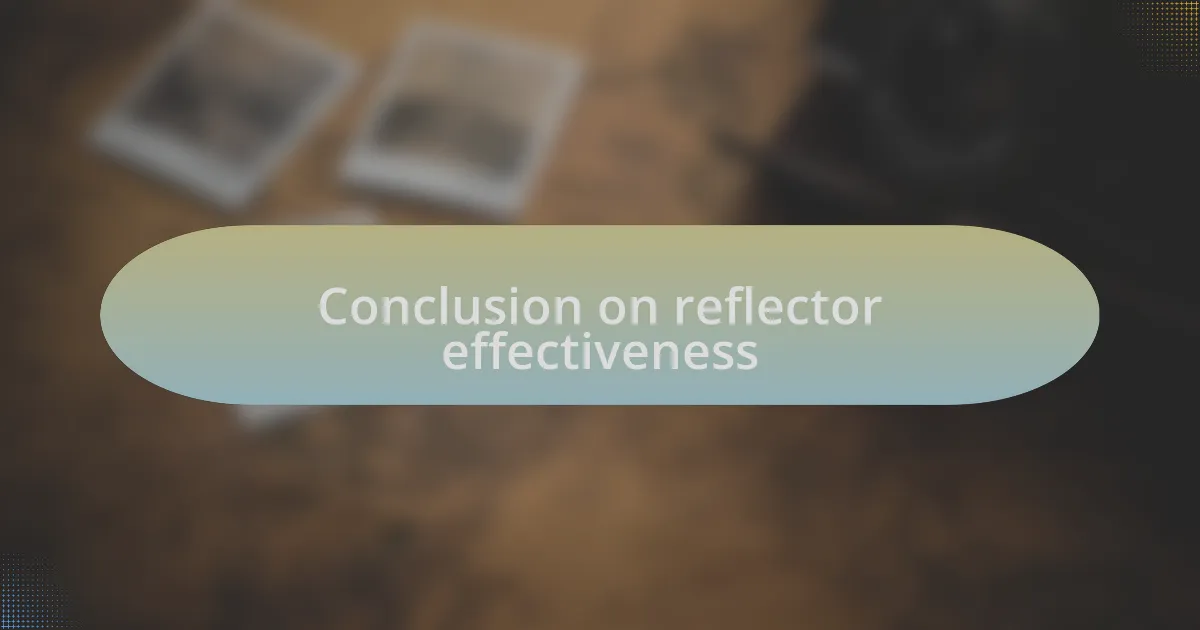
Conclusion on reflector effectiveness
The effectiveness of reflectors in photography cannot be overstated. I fondly recall a project where I used a gold reflector during a sunset shoot. The warm tones it added weren’t just a nice touch; they completely transformed the images, creating an inviting atmosphere that my clients loved. Have you ever experimented with different reflector colors to see how they can alter the ambiance of your photos?
Interestingly, I’ve often found that reflectors are not just about bouncing light; they also play a crucial role in shaping the narrative of an image. During one shoot, I aimed a white reflector toward my subject, illuminating their face just enough to create a striking contrast with the dark background. It was a subtle change, but it made the subject pop in a way I hadn’t anticipated. Isn’t it fascinating how small adjustments can yield such powerful results?
Ultimately, the effectiveness of reflectors hinges on our awareness and creativity as photographers. It’s not just about the right tools; it’s about how we utilize them to tell a story. Each experience I’ve had with reflectors has reinforced my belief that they are essential in my toolkit. Do you see reflectors as merely accessories, or do you view them as vital storytelling tools in your photography?